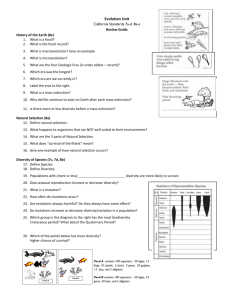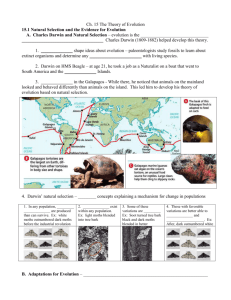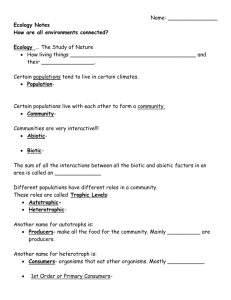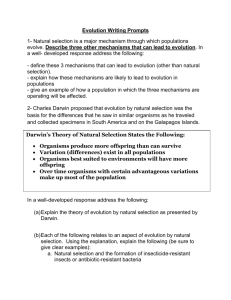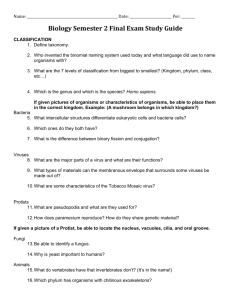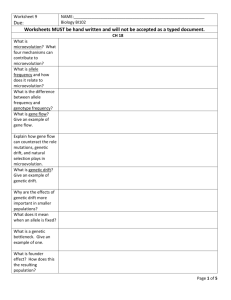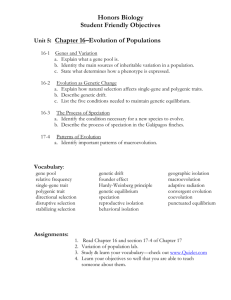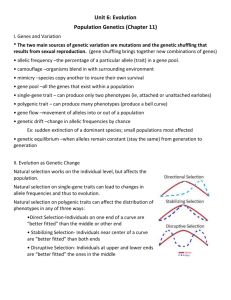Natural Selection (8a)
advertisement
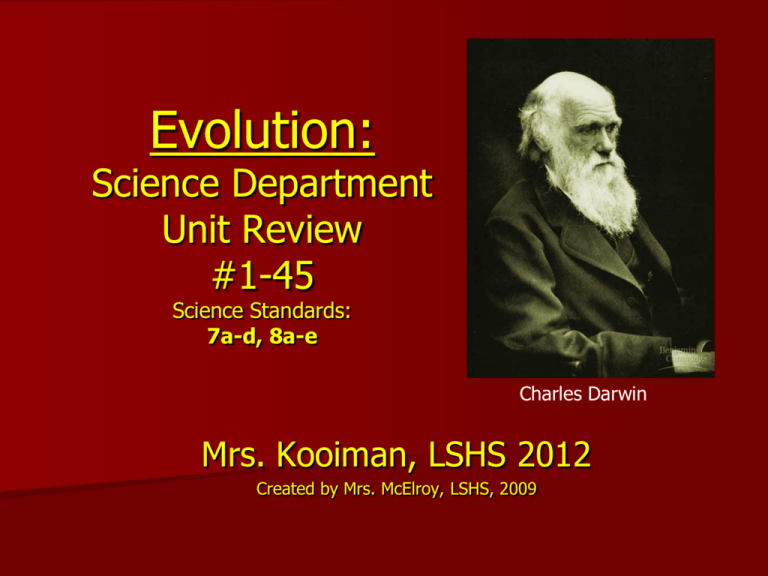
Evolution: Science Department Unit Review #1-45 Science Standards: 7a-d, 8a-e Charles Darwin Mrs. Kooiman, LSHS 2012 Created by Mrs. McElroy, LSHS, 2009 History of the Earth (8e) 1. What is a fossil? History of the Earth (8e) 1. What is a fossil? remains of ancient life 2. What is the fossil record? 2. What is the fossil record? all the information about past life 3. What is macroevolution? Give an example. 3. What is macroevolution? Give an example. evolution over long periods of time (millions of years) ex Fossil Record Macro = “Big Picture” 4. What is microevolution? 4. What is microevolution? all of the small changes in genes that happen in a few generations ex Light and Dark Moths, England 5. What are the four Geologic Eras (in order oldest – recent)? 5. What are the four Geologic Eras (in order oldest – recent)? Most Recent Oldest 6. Which era was the longest? 6. Which era was the longest? Precambrian 7. Which era are we currently in? 7. Which era are we currently in? Cenozoic 8. Label the eras below. A. B. C. 8. Label the eras below. A. B. C. Mesozoic Paleozoic Precambrian 9. What is a mass extinction? 9. What is a mass extinction? a large number of unrelated species quickly die 10. Why did life continue to exist on Earth after each mass extinction? 10. Why did life continue to exist on Earth after each mass extinction? new habitats and resources were available to them 11. Is there more or less diversity before a mass extinction? 11. Is there more or less diversity before a mass extinction? More!! Natural Selection (8a) 12. Define natural selection: Natural Selection (8a) 12. Define natural selection: how individuals who are better suited to survive and reproduce successfully in their environment 13. What happens to organisms that are NOT well suited to their environments? 13. What happens to organisms that are NOT well suited to their environments? die or adapt 14. What are the 4 parts of Natural Selection? 14. What are the 4 parts of Natural Selection? 1.Overpopulation 2.Variation 3.Competition 4.Adaptations 15. What does “survival of the fittest” mean? 15. What does “survival of the fittest” mean? organisms with high levels of fitness (ability to survive, reproduce, and adapt) will survive and those with a lower level of fitness will die off. 16. Give one example of how natural selection occurs: 16. Give one example of how natural selection occurs: Darwin’s Finches: Finches in the Galápagos Islands have beaks adapted to eat the foods available in the birds’ habitats. Galapagos Tortoises: Tortoises on Hood Island have longer necks due to food availability. Diversity of Species (7c, 7d, 8b) 17. Define Species: Diversity of Species (7c, 7d, 8b) 17. Define Species: a group of similar organisms that can breed and produce fertile offspring 18. Define Diversity: 18. Define Diversity: a variety of something such as animals or plants (Pond A has more diversity) Pond B Pond A 19. Populations with (more or less) diversity are more likely to survive. 19. Populations with (more or less) diversity are more likely to survive. MORE 20. Does asexual reproduction increase or decrease diversity? 20. Does asexual reproduction increase or decrease diversity? DECREASE Because (like cloning) all of its offspring would be the same. 21. What is a mutation? 21. What is a mutation? is any change in a DNA sequence 22. How often do mutations occur: Constantly 23. Are mutations always harmful? Do they always have some effect? Most mutations are harmless, and some are helpful 24. Do mutations increase or decrease diversity in a population? 24. Do mutations increase or decrease diversity in a population? INCREASE 25. Which group in the diagram has the most biodiversity during the Cretaceous period? the Quaternary Period? 25. Which group in the diagram has the most biodiversity during the Cretaceous period? the Quaternary Period? Lizards and Lizards How? Look at the WIDEST band 26. Which of the ponds below has more diversity? Which has a higher chance of survival? Pond B Pond A Pond A contains 100 organisms - 30 algae, 15 frogs, 10 cattails, 5 ducks, 5 geese, 20 guppies, 13 bass, and 2 alligators. Pond B contains 100 organisms – 50 algae, 25 geese, 20 bass, and 5 alligators. 26. Which of the ponds below has more diversity? Which has a higher chance of survival? Pond B Pond A Pond A contains 100 organisms - 30 algae, 15 frogs, 10 cattails, 5 ducks, 5 geese, 20 guppies, 13 bass, and 2 alligators. Pond B contains 100 organisms – 50 algae, 25 geese, 20 bass, and 5 alligators. Pond A --because contains 8 types of organisms Pond A --because contains 4 types of organisms Genetics and Natural Selection (7a, 7b) 27. Does natural selection work directly on phenotypes or genotypes of an individual? Genetics and Natural Selection (7a, 7b) 27. Does natural selection work directly on phenotypes or genotypes of an individual? Phenotype (physical characteristic) ex leopards eat what they see…they don’t ask the prey what genotype they have! 28. The combined genetic information of all members of a population is called the . 28. The combined genetic information of all members of a population is called the . Gene Pool 29. Explain why lethal alleles, such as sickleshaped blood cells, continue to show up in the gene pool. 29. Explain why lethal alleles, such as sickleshaped blood cells, continue to show up in the gene pool. this disease is passed on by heterozygous individuals AND natural selection works on phenotype not genotype. 30. Why don’t carriers of these alleles get eliminated through natural selection? 30. Why don’t carriers of these alleles get eliminated through natural selection? Natural selection acts on phenotype—they are normal (carry the recessive gene but it is hidden by the dominant gene). 31. In England after the industrial revolution, dark moths had an advantage over light moths. If dark color in moths is dominant (D) why did light moths (dd) continue to reappear? 31. In England after the industrial revolution, dark moths had an advantage over light moths. If dark color in moths is dominant (D) why did light moths (dd) continue to reappear? When heterzygous, dark moths mate (Dd X Dd), they produce light moths (dd). D D d d DD Dd Dd dd Genetic Drift (8c) 32. In genetic drift, changes in allele (gene) frequencies change due to . Genetic Drift (8c) 32. In genetic drift, changes in allele (gene) frequencies change due to . RANDOM EVENTS or CHANCE! Why? In small populations, Natural Selection is not the only source of evolutionary change and the laws of probability (genetics) don’t really work. 33. Genetic drift occurs in population that are in size. 33. Genetic drift occurs in population that are in size. small GENETIC DRIFT: In small populations, individuals that carry a particular allele may have more descendants than other individuals. Over time, a series of chance occurrences of this type can cause an allele to become more common in a population. 34. What is the bottleneck effect? 34. What is the bottleneck effect? Is what happens when only a few members survive a major catastrophe and pass on those genotypes 35. Give an example of a situation that could cause the bottleneck effect? 35. Give an example of a situation that could cause the bottleneck effect? Flood, fire, earthquake, meteorite, worldwide disease 36. The type of genetic drift that follows colonization of a new habitat by a small group of individuals is called . Original Popn. New Popn. 36. The type of genetic drift that follows colonization of a new habitat by a small group of individuals is called . Founder Effect Original Popn. New Popn. 37. The Amish people having an unusually high occurrence of six fingers are an example of . 37. The Amish people having an unusually high occurrence of six fingers are an example of . Founder Effect 38. Label the 3 graphs below. 38. Label the 3 graphs below. Graph A: Directional Selection Graph B. Stabilizing Selection Graph C: Disruptive Selection Speciation (8d) 39. Define speciation: Speciation (8d) 39. Define speciation: is the evolutionary process by which new biological species arise. is the result of reproductive isolation 40. Why are horses and donkeys considered to be two different species? (think about the definition of species) Species: a group of similar organisms that can breed and produce fertile offspring 40. Why are horses and donkeys considered to be two different species? (think about the definition of species) Species: a group of similar organisms that can breed and produce fertile offspring They usually don’t breed naturally. When they do, they produce a mule; most mules are sterile. Mule 41. Define Reproductive Isolation. Give 3 examples: 41. Define Reproductive Isolation: Is when the members of different populations cannot interbreed and new species come up ex 1. Behavioral Isolation 2. Geographic Isolation 3. Temporal Isolation 42. What happens when animals are unable to reproduce for long periods of time with another population of the same animal? 42. What happens when animals are unable to reproduce for long periods of time with another population of the same animal? They become reproductively isolated and gene pool differences increase – eventually may evolve into two different species 43. Define Temporal Isolation: 43. Define Temporal Isolation: occurs when two populations are unable to reproduce due to different mating times/seasons. 44. Define Geographic Isolation: 44. Define Geographic Isolation: occurs when two populations are separated by geographic barriers such as rivers, mountains, or bodies of water 45. What happens two populations of animals are geographically isolated for long periods of time and as a result can no longer reproduce with each other? 45. What happens two populations of animals are geographically isolated for long periods of time and as a result can no longer reproduce with each other? They become different species “Speciation” STUDY!!!
